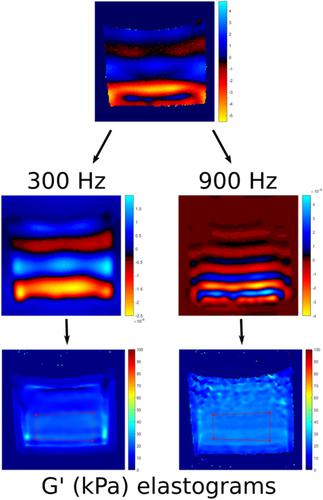当前位置:
X-MOL 学术
›
NMR Biomed.
›
论文详情
Our official English website, www.x-mol.net, welcomes your
feedback! (Note: you will need to create a separate account there.)
Harmonic wideband simultaneous dual‐frequency MR Elastography
NMR in Biomedicine ( IF 2.7 ) Pub Date : 2020-11-11 , DOI: 10.1002/nbm.4442 Pilar Sango Solanas 1 , Kevin Tse Ve Koon 1 , Helene Ratiney 1 , Fabien Millioz 1 , Cyrielle Caussy 2, 3 , Olivier Beuf 1
NMR in Biomedicine ( IF 2.7 ) Pub Date : 2020-11-11 , DOI: 10.1002/nbm.4442 Pilar Sango Solanas 1 , Kevin Tse Ve Koon 1 , Helene Ratiney 1 , Fabien Millioz 1 , Cyrielle Caussy 2, 3 , Olivier Beuf 1
Affiliation

|
Magnetic resonance elastography (MRE) is used to non‐invasively quantify viscoelastic properties of tissues based on the measurement of propagation characteristics of shear waves. Because some of these viscoelastic parameters show a frequency dependence, multifrequency analysis allows us to measure the wave propagation dispersion, leading to a better characterization of tissue properties. Conventionally, motion encoding gradients (MEGs) oscillating at the same frequency as the mechanical excitation encode motion. Hence, multifrequency data is usually obtained by sequentially repeating monochromatic wave excitations experiments at different frequencies. The result is that the total acquisition time is multiplied by a factor corresponding to the number of repetitions of monofrequency experiments, which is a major limitation of multifrequency MRE. In order to make it more accessible, a novel single‐shot harmonic wideband dual‐frequency MRE method is proposed. Two superposed shear waves of different frequencies are simultaneously generated and propagate in a sample. Trapezoidal oscillating MEGs are used to encode mechanical vibrations having frequencies that are an odd multiple of the MEG frequency. The number of phase offsets is optimized to reduce the acquisition time. For this purpose, a sampling method not respecting the Shannon theorem is used to produce a controlled temporal aliasing that allows us to encode both frequencies without any additional examination time. Phantom experiments were run to compare conventional monofrequency MRE with the single‐shot dual‐frequency MRE method and showed excellent agreement between the reconstructed shear storage moduli G′. In addition, dual‐frequency MRE yielded an increased signal‐to‐noise ratio compared with conventional monofrequency MRE acquisitions when encoding the high frequency component. The novel proposed multifrequency MRE method could be applied to simultaneously acquire more than two frequency components, reducing examination time. Further studies are needed to confirm its applicability in preclinical and clinical models.
中文翻译:

谐波宽带同步双频磁共振弹性成像
磁共振弹性成像 (MRE) 用于基于对剪切波传播特性的测量,以非侵入性方式量化组织的粘弹性。由于其中一些粘弹性参数显示出频率相关性,因此多频分析使我们能够测量波传播色散,从而更好地表征组织特性。通常,运动编码梯度 (MEG) 以与机械激励编码运动相同的频率振荡。因此,多频数据通常是通过在不同频率下顺序重复单色波激发实验来获得的。结果是总采集时间乘以与单频实验重复次数相对应的因子,这是多频 MRE 的主要限制。为了使其更易于访问,提出了一种新颖的单次谐波宽带双频 MRE 方法。两个不同频率的叠加横波同时产生并在样品中传播。梯形振荡 MEG 用于对频率为 MEG 频率奇数倍的机械振动进行编码。优化相位偏移的数量以减少采集时间。为此,不遵守香农定理的采样方法用于产生受控的时间混叠,使我们能够对两个频率进行编码,而无需任何额外的检查时间。进行了体模实验以比较传统的单频 MRE 与单次双频 MRE 方法,结果表明重建的剪切储能模量之间具有极好的一致性G ′。此外,在对高频分量进行编码时,与传统的单频 MRE 采集相比,双频 MRE 产生了更高的信噪比。新提出的多频 MRE 方法可用于同时获取两个以上的频率分量,从而减少检查时间。需要进一步的研究来证实其在临床前和临床模型中的适用性。
更新日期:2021-01-04
中文翻译:

谐波宽带同步双频磁共振弹性成像
磁共振弹性成像 (MRE) 用于基于对剪切波传播特性的测量,以非侵入性方式量化组织的粘弹性。由于其中一些粘弹性参数显示出频率相关性,因此多频分析使我们能够测量波传播色散,从而更好地表征组织特性。通常,运动编码梯度 (MEG) 以与机械激励编码运动相同的频率振荡。因此,多频数据通常是通过在不同频率下顺序重复单色波激发实验来获得的。结果是总采集时间乘以与单频实验重复次数相对应的因子,这是多频 MRE 的主要限制。为了使其更易于访问,提出了一种新颖的单次谐波宽带双频 MRE 方法。两个不同频率的叠加横波同时产生并在样品中传播。梯形振荡 MEG 用于对频率为 MEG 频率奇数倍的机械振动进行编码。优化相位偏移的数量以减少采集时间。为此,不遵守香农定理的采样方法用于产生受控的时间混叠,使我们能够对两个频率进行编码,而无需任何额外的检查时间。进行了体模实验以比较传统的单频 MRE 与单次双频 MRE 方法,结果表明重建的剪切储能模量之间具有极好的一致性G ′。此外,在对高频分量进行编码时,与传统的单频 MRE 采集相比,双频 MRE 产生了更高的信噪比。新提出的多频 MRE 方法可用于同时获取两个以上的频率分量,从而减少检查时间。需要进一步的研究来证实其在临床前和临床模型中的适用性。











































 京公网安备 11010802027423号
京公网安备 11010802027423号